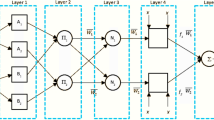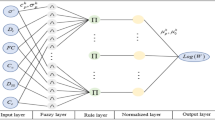Abstract
Reliable determination of seismic liquefaction potential of soil is an important obligation in earthquake engineering. In this study, neuro-fuzzy group method of data handling (NF-GMDH) was employed for prediction of strain energy required to induce liquefaction. The NF-GMDH-based model was developed using particle swarm optimization. A wide-ranging database of soil element tests was used to develop an advanced model, capable of predicting soil liquefaction resistance accurately. Input variables of the model were chosen based on the previous studies on the liquefaction potential assessment. Results of geotechnical centrifuge tests were also involved during the training process for adequate generalization of the proposed model for future predictions. A parametric analysis was then performed to evaluate sensitivity of the proposed model to variations of the influencing parameters. A comparison between performance of the developed model and previously recommended relationships was done. The results clearly demonstrate that the proposed model, which was derived based on laboratory results, can be successfully utilized for strain energy-based estimation of liquefaction potential.











Similar content being viewed by others
References
Alavi AH, Gandomi AH (2012) Energy-based numerical models for assessment of soil liquefaction. Geosci Front 3(4):541–555
Arulmoli K, Muraleetharan KK, Hosain MM, Fruth L S (1992) VELACS laboratory testing program. Soil data report, the earth technology corporation, Irvine, Calif. Report to the National Science Foundation, Washington, DC
Baykasoglu A, Cevik A, Ozbakir L, Kulluk S (2009) Generating prediction rules for liquefaction through data mining. Expert Syst Appl 36:12491–12499
Baziar MH, Jafarian Y (2007) Assessment of liquefaction triggering using strain energy concept and ANN model: capacity energy. Soil Dyn Earthq Eng 27(12):1056–1072
Baziar MH, Jafarian Y, Shahnazari H, Movahed V, Tutunchian MA (2011) Prediction of strain energy-based liquefaction resistance of sand–silt mixtures: an evolutionary approach. Comput Geosci 37(11):1883–1893
Carraro JAH, Bandini P, Salgado R (2003) Liquefaction resistance of clean and nonplastic silty sands based on cone penetration resistance. J Geotech Geoenviron Eng 129(11):965–976
Dabiri R, Askari F, Shafiee A, Jafari MK (2011) Shear wave velocity-based liquefaction resistance of sand-silt mixtures: deterministic versus probabilistic approach. Iran J Sci Technol Trans B Eng 35:199–215
Dief HM, Figueroa JL (2001) Liquefaction assessment by the energy method through centrifuge modeling. In: Zeng XW (ed) Proceedings of the NSF international workshop on earthquake simulation in geotechnical engineering. CWRU, Cleveland
Dief H M (2000) Evaluating the liquefaction potential of soils by the energy method in the centrifuge. Ph.D dissertation, Department of Civil Engineering, Case Western Reserve University, Cleveland, OH
Dobry R, Ladd RS, Yokel FY, Chung RM, Powell D (1982) Prediction of pore water pressure build-up and liquefaction of sands during earthquakes by the cyclic strain method. National Bureau of Standards, US Department of Commerce, US Governmental Printing Office, Building Science Series, Washington, DC
Figueroa JL, Saada AS, Liang L, Dahisaria MN (1994) Evaluation of soil liquefaction by energy principles. J Geotech Geoenviron Eng 20(9):1554–1569
Green RA (2001) Energy-based evaluation and remediation of liquefiable soils. Ph.D dissertation, Virginia Polytechnic Institute and State University, Blacksburg, VA
Hazirbaba K, Rathje EM (2009) Pore pressure generation of silty sands due to induced cyclic shear strains. J Geotech Geoenviron Eng 135(12):1892–1905
Heidari A (2008) Artificial neural network (theory and application with MATLAB). Nazeran, Esfahan (In Persian)
Heidari A (2010) Optimum design of structures for earthquake induced loading by genetic algorithm using wavelet transform. Adv Appl Math Mech 2(1):107–117
Heidari A (2011) Calculation of frequency of retaining wall by back propagation neural network. Asian J Civil Eng 12(3):267–278
Heidari A, Salajegheh E (2006) Time history analysis of structures for earthquake loading by wavelet networks. Asian J Struct Eng 7:155–168
Hwang HS (2006) Fuzzy GMDH-type neural network model and its application to forecasting of mobile communication. Comput Ind Eng 50:450–457
Ishihara K, Yasuda S (1975) Sand liquefaction in hollow cylinder torsion under irregular excitation. Soils Found 15(1):45–59
Ivakhnenko AG (1971) Polynomial theory of complex systems. IEEE Trans Syst Man Cybern 1:364–378
Jafarian Y, Sadeghi Abdollahi A, Vakili R, Baziar MH, Noorzad A (2011) On the efficiency and predictability of strain energy for the evaluation of liquefaction potential: a numerical study. Comput Geotech 38(6):800–808
Jafarian Y, Haddad A, Javdanian H (2014) Predictive model for normalized shear modulus of cohesive soils. Acta Geodyn Geomater 11(1):89–100
Javdanian H, Haddad A, Mehrzad B (2012) Experimental and numerical investigation of the bearing capacity of adjacent footings on reinforced soil. Electron J Geotech Eng 17(R):2597–2617
Javdanian H, Jafarian Y, Haddad A (2015) Predicting damping ratio of fine-grained soils using soft computing methodology. Arab J Geosci 8(6):3959–3969
Kalantary F, Ardalan H, Nariman-Zadeh N (2009) An investigation on the Su-NSPT correlation using GMDH type neural networks and genetic algorithms. Eng Geol 104:144–155
Kennedy J, Eberhart RC (1995) Particle swarm optimization. In: Proc. of the fourth IEEE int. conf. on neural networks, pp 1942–1948
Lee KL, Fitton JA (1969) Factors affecting the cyclic loading strength of soil. Vib Eff Earthq Soils Found 450:71–95
Liang L (1995) Development of an energy method for evaluating the liquefaction potential of a soil deposit. Ph.D dissertation, Department of Civil Engineering, Case Western Reserve University, Cleveland, OH
Madala HR, Ivakhnenko AG (1994) Inductive learning algorithms for complex systems modeling. CRC Press, Boca Raton
Masters T (1993) Practical neural network recipes in C++. Academic press, San Diego
McCombie P, Wilkinson P (2002) The use of the simple genetic algorithm in finding the critical factor of safety in slope stability analysis. Comput Geotech 29:699–714
Nagasaka K, Ichihashi H, Leonard R (1995) Neuro-fuzzy GMDH and its application to modeling grinding characteristics. Int J Prod Res 33(5):1229–1240
Najafzadeh M (2014) Neuro-fuzzy GMDH system based particle swarm optimization for prediction of scour depth at downstream of grade control structures. Eng Sci Technol Int J 18(1):42–45
Najafzadeh M, Azamathulla HM (2013a) Group method of data handling to predict scour depth around bridge piers. Neural Comput Appl 23:2107–2112
Najafzadeh M, Azamathulla HM (2013b) Neuro-fuzzy GMDH systems to predict the scour pile groups due to waves. J Comput Civil Eng. doi:10.1061/(ASCE)CP.1943-5487.0000376
Najafzadeh M, Lim SY (2014) Application of improved neuro-fuzzy GMDH to predict scour downstream of sluice gates. Earth Sci Inform 8(1):187–196
Najafzadeh M, Barani GA, Azamathulla HM (2013a) GMDH to prediction of scour depth around vertical piers in cohesive soils. Appl Ocean Res 40:35–41
Najafzadeh M, Barani GA, Hessami Kermani MR (2013b) GMDH network based back propagation algorithm to predict abutment scour in cohesive soils. Ocean Eng 59:100–106
Najafzadeh M, Barani GA, Azamathulla HM (2014a) Prediction of pipeline scour depth in clear-water and live-bed conditions using group method of data handling. Neural Comput Appl 24:629–635
Najafzadeh M, Barani GA, Hessami-Kermani MR (2014b) Group method of data handling to predict scour at downstream of a ski-jump bucket spillway. Earth Sci Inform 7(4):231–248
National Research Council (1985) Liquefaction of soils during earthquakes. National research council report CETS-EE-001. National Academy Press, Washington
NCEER (1997) In: Proceedings of the NCEER workshop on evaluation of liquefaction resistance of soils. National Center for Earthquake Engineering Research, Technical Report No. NCEER970022, State University of New York at Buffalo, New York
Oh HJ, Pradhan B (2011) Application of a neuro-fuzzy model to landslide-susceptibility mapping for shallow landslides in a tropical hilly area. Comput Geosci 7(9):1264–1276
Ohtani T, Ichihashi H, Miyoshi T, Nagasaka K (1998) Orthogonal and successive projection methods for the learning of neurofuzzy GMDH. Inform Sci 110(1):5–24
Onwubolu GC (2008) Design of hybrid differential evolution and group method in data handling networks for modeling and prediction. Inform Sci 178:3618–3634
Penumadu D, Zhao R (1999) Triaxial compression behavior of sand and gravel using artificial neural networks (ANN). Comput Geotech 24:207–230
Polito CP, Martin JR (2001) Effects of nonplastic fines on the liquefaction resistance of sands. J Geotech Geoenviron Eng 127(5):408–415
Rakhshandehroo GR, Ghadampour Z (2011) A combination of fractal analysis and artificial neural network to forecast groundwater depth. Iran J Sci Technol Trans B Eng 35:121–130
Saikia R, Chetia M (2014) Critical review on the parameters influencing liquefaction of soils. Int J innov Res Sci Eng Technol 3:110–116
Salajegheh E, Heidari A (2004) Optimum design of structures against earthquake by adaptive genetic algorithm using wavelet networks. Struct Multidiscip Optim 28:277–285
Seed HB, Idriss IM (1971) Simplified procedure for evaluating soil liquefaction potential. J Soil Mech Found Div 97:1249–1273
Seed HB, Mori K, Chan CK (1975) Influence of seismic history on the liquefaction characteristics of sands. Report EERC 75-25, Earthquake Engineering Research Center, University of California, Berkeley
Shahin MA, Maier HR, Jaksa MB (2002) Predicting settlement of shallow foundations using neural networks. J Geotech Geoenviron Eng 128(9):785–793
Shi Y, Eberhart R C (1998) A modified swarm optimizer, In: Proc. of the IEEE int. conf. on evolutionary computation, Anchorage, pp 69–73
Tabesh M, Dini M (2009) Fuzzy and neuro-fuzzy models for short-term water demand forecasting in Tehran. Iran J Sci Technol Trans B Eng 33:61–77
Towhata I, Ishihara K (1985) Shear work and pore water pressure in undrained shear. Soils Found 25(3):73–84
Whitman RV (1971) Resistance of soil to liquefaction and settlement. Soils Found 11(4):59–68
Youd T, Idriss I, Andrus R, Arango I, Castro G, Christian J, Dobry R, Finn W, Harder LJ, Hynes M, Ishihara K, Koester J, Liao S, Marcuson W, Martin G, Mitchell J, Moriwaki Y, Power M, Robertson P, Seed R, Stokoe K II (2001) Liquefaction resistance of soils: summary report from the 1996 NCEER and 1998 NCEER/NSF workshops on evaluation of liquefaction resistance of soils. J Geotech Geoenviron Eng 127(10):817–833
Author information
Authors and Affiliations
Corresponding author
Rights and permissions
About this article
Cite this article
Javdanian, H., Heidari, A. & Kamgar, R. Energy-Based Estimation of Soil Liquefaction Potential Using GMDH Algorithm. Iran J Sci Technol Trans Civ Eng 41, 283–295 (2017). https://doi.org/10.1007/s40996-017-0061-4
Received:
Accepted:
Published:
Issue Date:
DOI: https://doi.org/10.1007/s40996-017-0061-4




